#fukushima prefectural museum
Text
福島県
Japanese Prefectures: Tohoku - Fukushima
都道府県 (とどうふけん) - Prefectures of Japan
Learning the kanji and a little bit about each of Japan’s 47 prefectures!
Kanji・漢字
福 フク blessing, fortune
島 しま、トウ island
県 ケン prefecture
東北 とうほく north-east, Tohoku (northernmost six prefectures of Honshu)
Prefectural Capital (県庁所在地) : Fukushima (福島市)
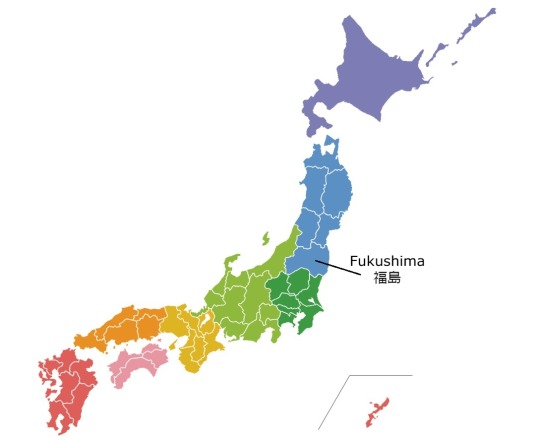
Fukushima is the third largest prefecture of the 47 prefectures of Japan and stretches between the mountainous interior of Northern Honshu to the Pacific Ocean. Like most of the other Tohoku prefectures, Fukushima boasts expansive natural beauty, relaxing hot springs, a rich history, and excellent ski resorts. The feudal Aizu Clan, of the still-standing castle town of Aizu-Wakamatsu, remained loyal to the shogun, even after the shogun was removed from power during the Meiji Restoration. This loyalty led to the Aizu area becoming a battleground of the Boshin War in 1868, where those loyal to the shogun were pushed northwards into Tohoku and Hokkaido as they resisted the reformers and those loyal to the emperor. The Aizu area boasts the post town of Ouchijuku, with buildings retained from the samurai era; Tsuruga Castle; hot springs; and a famous sake brewery.
The March 2011 earthquake and tsunami devastated the coastal areas of Fukushima Prefecture and caused a nuclear accident at the Fukushima Daiichi Nuclear Plant. Tens of thousands of residents were evacuated and a no-entry zone was set up around the nuclear plant. The no-entry zone makes up less than 3% of the prefecture's area, and even inside most of the no-entry zone, radiation levels have declined far below the levels that airplane passengers are exposed to at cruising altitude. Thus Fukushima has been deemed safe for tourists to visit. Wide areas of western Fukushima, in particular, escaped much contamination, including the mountainous interior around the historic city of Aizu-Wakamatsu. And even in most of the eastern parts of the prefecture, radiation levels have by now decreased to pre-2011 levels due to natural decay and decontamination efforts.
Recommended Tourist Spot・おすすめ観光スポット
Ouchijuku - 大内宿
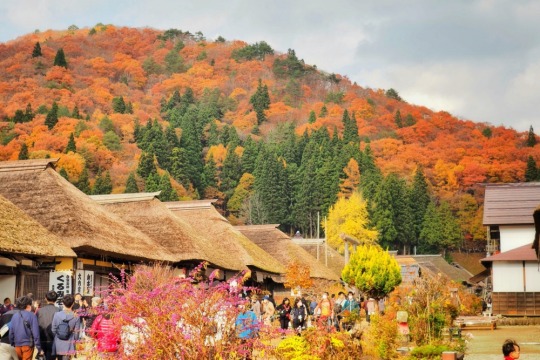
Photo by JR Times
If you want a taste of Edo Period Japan, Ouchijuku is the place for you. This is a former post town along the Aizu-Nishi Kaido trade route, which connected the centers of Aizu (a former castle town to the north in Fukushima) and Nikko (to the south in Tochigi prefecture) during the Edo Period. Restrictions set by the shogunate required travelers to make the journey on foot, and thus post towns such as Ouchijuku developed along the route to provide food, accommodation, and rest. Ouchijuku has been restored to look as it did in the Edo Period, with thatched roof buildings that house a variety of shops, restaurants, and minshuku (small traditional Japanese inns).
The former Honjin, or principal inn for high ranking government officials, is currently a museum, offering an example of elegant traditional housing interiors of the Edo Period and includes a collection of dishes, clothing, and other artifacts.
The Takakura Shrine is a five minute walk off the main path and hosts a unique purification fountain in the midst of a stand of Japanese cedar trees, and was dedicated to Prince Mochihito, who died in June 1180. Near the beginning of the Genpei War (1180-1185) during the Battle of Uji, the prince fled to the Phoenix Hall of the Byōdō-in temple, where he was later captured and killed at the torii gate of Kōmyōsan. It was said that he managed to escape, and hid in Ouchijuku.
Shohoji Temple is located at the end of the main street and up a steep flight of stairs. At the top of the path visitors can enjoy a panoramic view of Ouchijuku and its surroundings.
Regional Cuisine - 郷土料理
Kitakata Ramen - 喜多方ラーメン
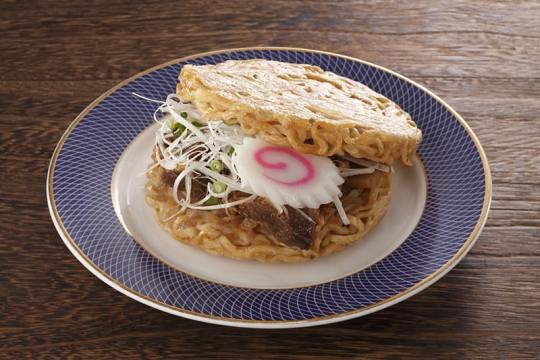
Photo by JR Times
Kitakata ramen is a gourmet specialty from Kitakata, Fukushima prefecture. The origin of these noodles is said to be from Chinese noodles sold in stalls by young people who had come from China from 1920-1930. The noodles are thick and flat with a firm appearance and texture and a relatively high moisture level. The soup is a soy base, with flavors varying depending on the shop, from miso to salt. To determine where to eat, there is a Ramen Map located at the tourist information center in Kitakata.
The popular Kitakata Ramen Burger is made from baked and hardened noodles together with pork, menma, and green onions. Kitakata is also known for its unique culture of eating ramen early in the morning. People who started work very early in the morning at sake breweries and on farms would eat ramen early in the morning, and thus the habit began. "Morning ramen" is available at many shops in the area.
Fukushima Dialect・Fukushima-ben・福島弁
Fukushima-ben or the dialect of Fukushima is similar in some ways to the other Tohoku (or North-East Japan) dialects, but also has some key differences. Here are some interesting phrases I found.
洗濯物をおっこむ (sentakumono o okkomu)
Standard Japanese: 洗濯物を取り込む (sentakumono o torikomu)
English: to take in the laundry
ぶっちめた (bucchimeta)
Standard Japanese: ぶつけた (butsuketa)
English: to hit (e.g. one's head)
すっぺったこっぺった (suppetta koppetta)
Standard Japanese: ごちゃごちゃ言うな (gocha gocha iu na)
English: don't complain about it
うっちしい (ucchishii)
Standard Japanese: うるさい (urusai)
English: noisy, annoying
#japanese prefectures#日本語#japanese#japanese language#japanese langblr#langblr#studyblr#都道府県#福島県#fukushima
85 notes
·
View notes
Text

"Haniwa and Earthenware (J)" [ハニワと土器 (J)] by Saitō Kiyoshi (斎藤清), 1952
"Haniwa y loza (J)" de Saitō Kiyoshi, 1952
From the collection of the Kiyoshi Saito Museum of Art in Yanaizu City, Fukushima Prefecture
#japanese art#arte japonés#斎藤清#saito kiyoshi#埴輪#haniwa#創作版画#sosaku hanga#japanese p#japanese prints#impresiones japonesas#wood#woodblock print#grabado en madera
12 notes
·
View notes
Text
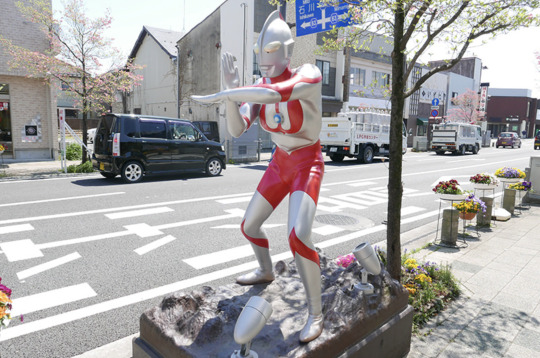

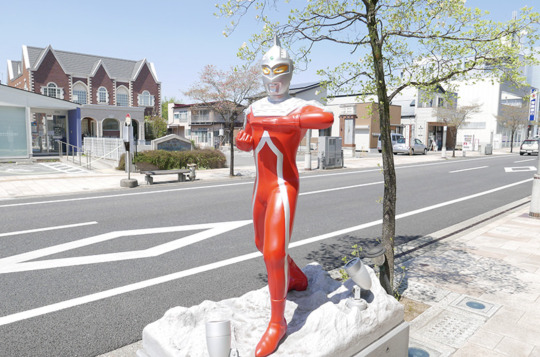
Sukugawa, Fukushima Prefecture by viewtabi.jp
The hometown of director Eiji Tsuburaya, who is hailed as the ``God of special effects.'' A place where you can find Ultraman and friends statues scattered around the city where there is a museum where you get to know more about the behind the scenes of the shows.
#sukugawa#fukushima#japan#ultraman#eiji tsuburaya#tsuburaya productions#tsuburaya eiji#tsuburaya eiji museum#tokusatsu#ultra seven#ultraman 1966
8 notes
·
View notes
Text
Tsuruga Castle Fukushima Prefecture
鶴ヶ城 福島県🇯🇵
Tsuruga Castle, also known as Aizuwakamatsu Castle, is a historic Japanese castle located in Aizuwakamatsu, Fukushima Prefecture, Japan. Built in the 14th century, it played a significant role in the Boshin War during the Meiji Restoration. The castle's architecture is distinctive for its red roof tiles, earning it the nickname "Aka-jo" (Red Castle). Today, it serves as a museum and a symbol of Aizuwakamatsu's history.

9 notes
·
View notes
Photo

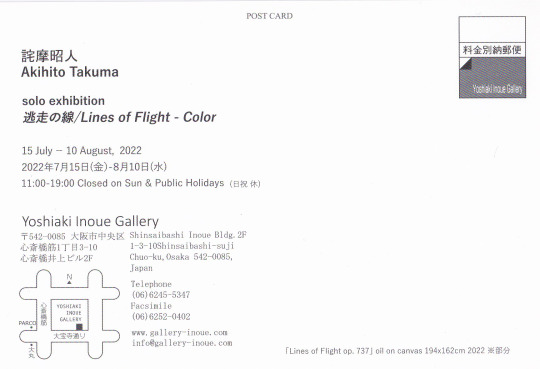
Akihito Takuma Solo exhibition, "Lines of Flight - Color"Yoshiaki Inoue gallery, Osaka, Japan
Jul.15 - Aug.10 , Closed on Sun & public holidays
11:00 - 19:00
https://gallery-inoue.com
Regarding my color paintings
It has been almost 18 years since I began creating "Lines of Flight," an oil painting done with one stroke with a brush two meters across. I tried many times in the past to create works in color, but I have never been able to produce anything satisfactory. But I decided to hold my first solo exhibition featuring color works, as I believe that for the first time I have something to show to you.
The concept of weaving between dichotomies is a theme that runs through the foundation of my work. I created my color works around two axes: "colored and achromatic," and "false and real images". The latter was inspired by landscape reflected on the surface of water.
With the pandemic beginning in 2020, and tensions in Ukraine cropping up in 2022, the world of today is one full of turbulence. But there is still beauty from the coming together of things, of things unfragmented. I hope you are able to enjoy the exhibit.
June, 2022 Akihito Takuma
Akihito Takuma1966 Born in Kumamoto, Japan
1993 Completed the postgraduate course at Shiga University
1993 - 94 Studied at Circulo de Bellas Artes de Madrid (Spain)
Lives and works in Tokyo & Kanagawa, Japan
Public collections
Hyogo Prefectural Museum of Art, Kobe/ Color museum, Tokyo/ Hirose collection/ Iwaki City Art Museum, Fukushima
11 notes
·
View notes
Text
I’M GOING TO JAPAN
AFTER 7 YEARS SINCE MY LAST VISIT.
AFTER 5 YEARS OF NOT TRAVELLING.
.
.
.
On Friday.
For two days.
It was kinda of an impulse trip after realising that there was still 6 months or half a year (I’m dying to travel) till my plan of visiting Japan in April next year at work and at night, after some considerable consideration, I booked a flight. .-.
Reason of going for only two days was because I do not have any leave I can take being an intern now and other than my two main purposes, I can’t fit my other goals into this trip now, like visiting related historical sites of shinsengumi. It will span into a two weeks trip at least 😂
Also.. my two main purposes of visiting Japan is...
Firstly... To visit Hijikata Toshizou Museum
Before it closes for an unknown period of time. (。•́︿•̀。)
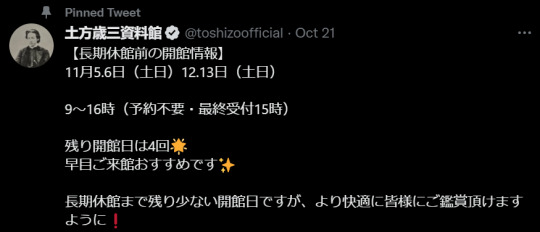
It had to be this weekend as the museum only opens on the 1st and 3rd Sundays of every month or in this case, as it is closing, the museum has extended the opening hours and days to earlier and on Saturdays as well. Its last opening weekend is on the 12 and 13 of November.
Secondly, to visit the Shinsengumi Exhibition 2022!

They have two venues ― the first one was held at Fukushima Prefectural Museum and the second one and last one is currently being held at The Museum of Kyoto, till 27 November this year.
I have no idea if this was the first ever exhibition of shinsengumi or will there ever be another one again.
So.... all the more for me to visit Japan and this two places right? RIGHT?
I actually booked the flight on 4 Oct and have been preparing for the trip like the entry procedures in Japan, what to bring, what to expect at the museum and exhibition and of course my Japanese skills... (→_→)
This is gonna be so exciting and nerve-racking but not anyone is able to do this, not even Japanese shinsengumi fans due to their infamous working hours and not anyone is as crazy as me so I’m gonna enjoy what I can! („• ᴗ •„)
#personal#shinsengumiten2022#shinsengumi#hijikatatoshizomuseum#hijikatatoshizoumuseum#新撰組#新選組#土方歳三資料館
6 notes
·
View notes
Text
#日本文化 #日本生活 #文化交流 #生活故事 #文化差異
🌸 Greetings from Sakata, Yamagata! Day 14 of my incredible journey across Japan continues to be a rollercoaster of emotions, filled with exhaustion, anticipation, and unexpected choices. 🌸
After two nights of uncertainty, not knowing where I would find a place to rest, I must admit, I'm feeling quite worn out. But today, there is a glimmer of hope on the horizon. I'm eagerly awaiting a message from Mr. Star, a friend who might offer me a place to stay in Fukushima starting tomorrow. The anticipation is palpable, and I can't help but feel hopeful.
Amidst the suspense, my wonderful host, Grandma Mika, took me on a captivating journey to a museum, where I learned about Yamagata's rich rice culture. This prefecture is renowned as one of the largest exporters of rice in Japan. To truly savor the essence of Yamagata, we indulged in a delicious meal featuring the region's exceptional rice at a local restaurant.
It was a day filled with enriching experiences and delightful discoveries. Just when I thought things couldn't get any better, I received a text from Mr. Star confirming that I can stay at his place! The excitement was overwhelming. However, another text from someone else arrived shortly after, leaving me torn between choices. What lies ahead on this intriguing path?
Now, I want to turn the spotlight to you, dear friends. What relationships do you hold dear? What connections are truly significant to you?
🌸 やっほー!山形県酒田からこんにちは!日本全国47都道府県をめぐる私の素晴らしい旅の14日目。この旅は、疲労感や期待感、思いがけない選択に満ちた感情のジェットコースターです。🌸
2泊もの間、宿が見つからず不安な日々でした。正直なところ、かなり疲れています。しかし、今日は望みの光が見えています。明日から福島で滞在先を提供してくれるかもしれない友達のスターさんからのメッセージを待ちわびています。期待が高まり、希望に胸を膨らませています。
ドキドキの中、素敵なホスト、ミカのおばあちゃんが私を連れて美術館へ案内してくれました。ここで山形の豊かな米の文化について学びました。この県は日本でも最大の米の輸出地として知られています。山形の本質を味わうため、地元のレストランでこの地域特産のお米を使った美味しい食事を楽しんできました。
今日は、心豊かな体験と素敵な発見に満ちた一日でした。もうこれ以上ないと思っていたときに、スターさんから私が彼の家に泊まれるとの確認のメッセージが届きました!興奮が抑えきれませんでした。しかし、その後、別の人からのメッセージが届き、どちらを選ぶべきか迷っています。この興味深い道の先には何が待っているのでしょうか?
さて、皆さんにスポットライトを当てたいと思います。大切な関係や真に意義のあるつながりは何ですか?
#日本縦断の旅 #心温まるつながり #思いがけない選択 #感情のジェットコースター #文化の探求 #期待感が高まる #友情の重要性 #ワンダーラストな冒険 #クリフハンガーモーメント #次の情報をお楽しみに
#日本文化 #日本生活 #文化交流 #生活故事 #文化差異 published first on https://www.youtube.com/@revywild
0 notes
Text
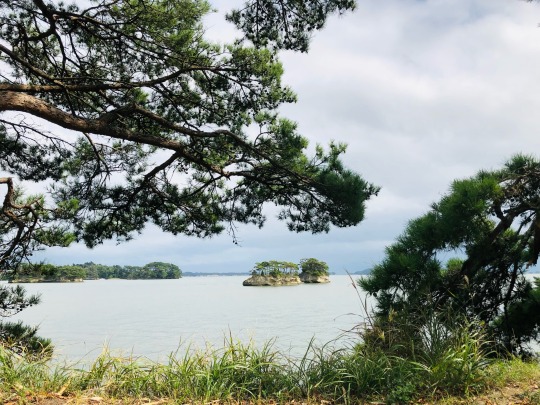


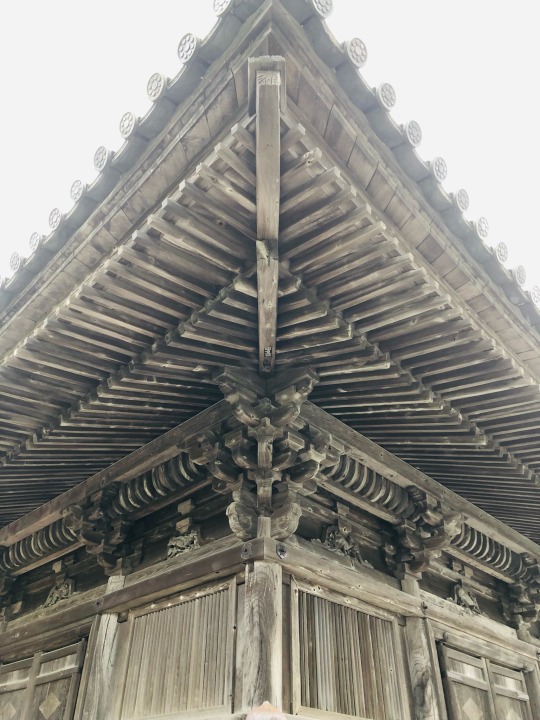
silver week: miyagi
september 22, 2022
>> see more matsushima photos <<
>> see all silver week 2022 posts <<
today was the day i was originally supposed to be in aizu-wakamatsu in fukushima prefecture. plans change, yadda yadda, and instead i ended up in matsushima in miyagi!
i’m actually not all that disappointed by the change, because matsushima was actually really nice, like a breath of fresh air. it is one of japan’s three exceptional scenic views (along with miyajima and amanohashidate). matsushima is a little town with a bay dotted with islets covered in pine trees. it was really cloudy and rainy the day i was able to go, but you can still see how matsushima bay got its reputation. also because of these islets, matsushima town was spared major damage from the 3/11 tsunami.
you can go onto some of these islets. i went onto oshima, which is a small islet to the south of matsushima bay. you can also go onto fukuura, which is a bit bigger and north of the bay. oshima was really cool to explore, but also kind of creepy because there are lots of caves and sometimes it felt like i had gone back in time and was the only one there lol.
the bay itself can be seen from a green park, and just north of the park is an extension of a famous temple -- it’s a little pagoda called godaido, and it’s on its own islet. you have to cross a couple of bridges to reach it. it’s really cool, the woodworking on the pagoda is pretty ornate.
the temple it’s connected to is called zuiganji and it’s a very important temple in tohoku. you can go into the main hall, but there weren’t any photos allowed. inside there are lots of gold screen paintings depicting birds and nature scenes and the islets themselves. it’s very pretty and extravagant. there’s also a museum of some treasures, but personally the main hall is the place to spend your time.
in the bathroom, the stalls are made of cedar trees. there’s a notice that tells visitors that the cedar trees which line the path into the temple were damaged in the tsunami and the ones that weren’t salvageable were used to make the bathrooms. i thought that was pretty cool, and it’s clear they’re trying to restore the cedar trees.
overall, matsushima was probably my favorite place i visited during the trip, though yamadera is a close second.
1 note
·
View note
Text

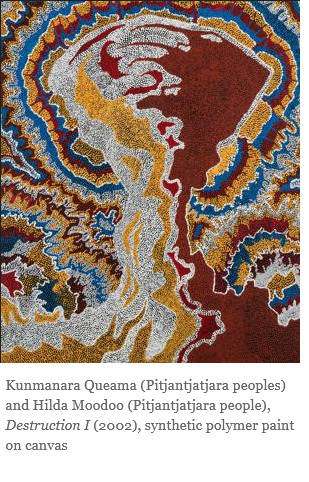
At 6.9 feet in height and 6.2 feet in diameter, Ainu artist Kohei Fujito’s iron sculpture, The Singing of the Needle (2021), is an imposing size, with an iron screen bristling with rough spirals barbed with spikes. A painted deer skull is mounted on a pole at its center, surrounded on all sides by the iron screen like it’s being shielded, from some external threat. In 2011, in the wake of the Fukushima Daiichi nuclear disaster in Japan, Fujito was concerned about the effect of radioactive winds on his Ainu family and community on Hokkaido, Japan’s northernmost prefecture.
“The spiral pattern throughout the work is based on a traditional Ainu symbol for wind,” says Manuela Well-Off-Man, chief curator at the Institute of American Indian Arts’ Museum of Contemporary Native Arts. [...]
Exposure: Native Art and Political Ecology is the first large-scale international exhibition of Indigenous artists responses to nuclear disaster and proliferation. It includes about 45 works by more than 30 Indigenous artists from the United States, Canada, Greenland, Japan, Australia, and the Pacific Islands.
The regions represented in the exhibition, which opens at IAIA MoCNA on Friday, Aug. 20 [2021], are united by similar narratives. Perhaps no toll visited on Earth by the deleterious effects of radiation is greater than that on its Indigenous communities.

Much of the nuclear testing and related disasters happened decades ago, often without public knowledge, and impacted communities who had insufficient understanding of the long-term effects. In the United States, the ramifications of widespread uranium extraction on tribal lands continues to this day. According to the Environmental Protection Agency, 75 percent of the nation’s 15,000 abandoned uranium mines are on Federal tribal land, including more than 1,000 on the Navajo Nation.

Diné photographer Will Wilson addresses the subject in his drone-based photographic triptych Mexican Hat Disposal Cell, Navajo Nation (2020-2021), which shows aerial views of contaminated uranium mines and mills, and in two images on display from his Autoimmune Response (AIR) series (circa 2005). The latter is an Indigenous futurist look at a post-apocalyptic world that situates its subject (Wilson donning a gas mask) in the majestic but toxic landscape of the Navajo Nation, which has a history of devastation caused by uranium, oil, and gas extraction.
Destruction I (2002) is located at the entrance of the Anne and Loren Kieve Gallery, where the main part of the exhibition is housed. It’s a 4-foot by 3-foot painting by Aboriginal artists Kunmanara Queama and Hilda Moodoo (both Pitjantjatjara people) that depicts a multicolored atomic mushroom cloud, rendered as a traditional Aboriginal dot painting.
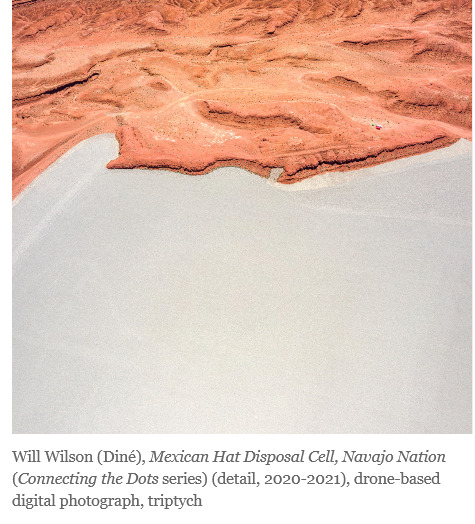
“What we’re doing with this exhibition is giving international Indigenous artists a voice to comment on the impact of nuclear exposure, like here in New Mexico, from the first atomic bomb development and tests but also from uranium mines,” Well-Off-Man says. “Similarly, in Australia, there were atomic bomb tests throughout the 1950s and ‘60s. Like here, with our uranium mines, these tests were conducted on Aboriginal land, without consulting with tribal governments and tribal elders. The government tried to move entire communities, but they didn’t really explain what would happen, and some of the Aboriginal tribal members stayed on the land. They never got the message, and they got severely sick or died of cancer.” [...]
A visual motif in the form of biohazard and radiation symbols runs through the exhibition. Samoan artist Dan Taulapapa McMullin’s Radiation Mats (2021) are intended as markers, alerting the viewer that the separate spaces are part of the same show. They also reflect the exhibition’s theme. The symbols are superimposed over photographic imagery of landscapes and people of the Bikini Atoll, whose inhabitants were forcibly removed in 1946 in advance of a series of nuclear tests conducted by the United States the following decade. When the inhabitants were allowed to return, more than two decades later, they were poisoned by high concentrations of the radioactive isotope Caesium-137 and high levels of Strontium-90 in the well water, prompting mass evacuations in 1980 [...]

Other works by McMullin include Clouds (2021), a video installation that places the history of nuclear testing in American Micronesia and French Polynesia into a contemporary context, and Te Mau Ata: Clouds (2021), a photo-collage depicting Bikini’s displaced people and French Polynesia’s anti-nuclear and independence activists amid the eponymous mushroom clouds created by nuclear blasts.
It’s significant that Exposure, which travels next year, launches in New Mexico, where the first atomic bomb test was conducted. That event was a precursor to the first deliberate use of a nuclear weapon (on the Japanese cities of Hiroshima and Nagasaki on Aug. 6 and 9, 1945) mere weeks after the historic test at Trinity Site, New Mexico, on July 16. [...]
Well-Off-Man organized the exhibition in collaboration with guest curators from around the world, including iBiennale Director Kóan Jeff Baysa, Hokkaido Museum of Modern Art Chief Curator and Vice Director Satomi Igarashi, and independent curator Tania Willard (Secwepemc Nation).
-------
Headline, images, captions, and all text published by: Michael Abatemarco. “Invisible invader: Indigenous artists respond to the nuclear legacy.” Santa Fe New Mexican. 20 August 2021.
3K notes
·
View notes
Photo




Today marks ten years since the March 2011 Tohoku Earthquake of magnitude 9.0 and subsequent tsunami. The powerful tsunami caused meltdowns of reactors at the Fukushima Daiichi Nuclear Power Plant. It was the most powerful earthquake ever recorded in Japan with catastrophic casualties, including 15,899 deaths, 6,157 injured, and 2,529 missing. Years later, approximately three thousand extra deaths have been confirmed as earthquake-related, bringing the total number of deaths to 19,575. (Information taken from Wikipedia.)
“Since March 11, 2011, disasters both natural and man-made have continued to happen around the world. The great fear of many who experienced the Great East Japan Earthquake and its aftermath is that these catastrophes will fade from memory. In Tohoku the endless mounds of twisted metal have been cleared away, and most of the landmarks of destruction made famous by news coverage have been dismantled. Yet recovery from the tsunami is far from complete, and the ongoing nuclear cleanup in Fukushima continues to affect not only personal lives but political developments. The photographs presented here ensure that what happened on that day will not be forgotten, while the power of their imagery invites us to contemplate, question, and yes, find profound beauty.” – (from Prologue, Anne Nishimura Morse and Anne E. Havinga, p.15.)
Unfortunately, on February 13, 2021, Fukushima experienced yet another powerful earthquake of magnitude over 7.0, resulting in nearly 200 people injured and more than 950,000 homes without power.
“In the wake : Japanese photographers respond to 3-11” was published in conjunction with an exhibition held at the Museum of Fine Arts, Boston, April 5 - July 12, 2015.
Image 1: Front cover, “Rasen Kaigan (Spiral Shore), 46, 2011, detail, by Leiko Shiga
Image 2: “Photographs Found after the Earthquake, Presented at the Kitakama Town Meeting, Miyogi Prefecture, 2011” by Leiko Shiga
Image 3: “April 25, 2011, Yamada, Iwate Prefecture” by Keizo Kitajima
Image 4: From the series, “Site/Cloud” 2012-2013 by Daisuke Yokota
In the wake : Japanese photographers respond to 3-11
Attribution: Anne Nishimura Morse and Anne E. Havinga ; with contributions by Michio Hayashi, Marilyn Ivy, and Tomoko Nagakura.
1st edition.
Boston : MFA Publications, [2015]
New York : ARTBOOK/D.A.P.
207 pages : illustrations (some color) ; 33 cm
English
Museum of Fine Arts, Boston [host institution]
ISBN : 9780878468270
ISBN : 0878468277
HOLLIS number: 990143807030203941
#tohokudaishinsai#tohokuearthquake#fukushima#earthquake#tsunami#東北大震災#東北大震災10年#福島#日本の写真家#japanesephotographer#japanesecontemporaryphotography#photography#harvardfineartslibrary#harvardfineartslib#fineartslibrary#Harvard#harvard library#HarvardLibrary
15 notes
·
View notes
Text

• Fu-Go Balloon Bomb
A Fu-Go, or fire balloon (風船爆弾, fūsen bakudan, lit. "balloon bomb"), was a weapon launched by Japan during World War II.
The fūsen bakudan campaign was the most earnest of the attacks. The concept was the brainchild of the Imperial Japanese Army's Ninth Army's Number Nine Research Laboratory, under Major General Sueyoshi Kusaba, with work performed by Technical Major Teiji Takada and his colleagues. The balloons were intended to make use of a strong current of winter air that the Japanese had discovered flowing at high altitude and speed over their country, which later became known as the jet stream. The jet stream reported by Wasaburo Oishi blew at altitudes above 30,000 ft (9.1 km) and could carry a large balloon across the Pacific in three days, over a distance of more than 5,000 miles (8,000 km). Such balloons could carry incendiary and high-explosive bombs to the United States and drop them there to kill people, destroy buildings, and start forest fires. The preparations were lengthy because the technological problems were acute. A hydrogen balloon expands when warmed by the sunlight, and rises; then it contracts when cooled at night, and descends. The engineers devised a control system driven by an altimeter to discard ballast. When the balloon descended below 30,000 ft (9.1 km), it electrically fired a charge to cut loose sandbags. The sandbags were carried on a cast-aluminium four-spoked wheel and discarded two at a time to keep the wheel balanced. Similarly, when the balloon rose above about 38,000 feet (12 km), the altimeter activated a valve to vent hydrogen. The hydrogen was also vented if the balloon's pressure reached a critical level.
The control system ran the balloon through three days of flight. By that time, it was likely over the U.S., and its ballast was expended. The final flash of gunpowder released the bombs, also carried on the wheel, and lit a 64 feet (20 meters) long fuse that hung from the balloon's equator. After 84 minutes, the fuse fired a flash bomb that destroyed the balloon. The balloon had to carry about 1,001 pounds (454 kg) of gear. At first the balloons were made of conventional rubberized silk, but improved envelopes had less leakage. An order went out for ten thousand balloons made of "washi", a paper derived from mulberry bushes that was impermeable and very tough. It was only available in squares about the size of a road map, so it was glued together in three or four laminations using edible konnyaku (devil's tongue) paste – though hungry workers stealing the paste for food created some problems. Many workers were nimble-fingered teenaged school girls.
The bombs most commonly carried by the balloons were, Type 92 33-pound (15 kg) high-explosive bomb consisting of 9.5 pounds (4.3 kg) picric acid or TNT surrounded by 26 steel rings within a steel casing 4 inches (10 cm) in diameter and 14.5 inches (37 cm) long and welded to a 11-inch (28 cm) tail fin assembly. Type 97 26-pound (12 kg) thermite incendiary bomb using the Type 92 bomb casing and fin assembly containing 11 ounces (310 g) of gunpowder and three 3.3-pound (1.5 kg) magnesium containers of thermite. 11-pound (5.0 kg) thermite incendiary bomb consisting of a 3.75-inch (9.5 cm) steel tube 15.75 inches (40.0 cm) long containing thermite with an ignition charge of magnesium, potassium nitrate and barium peroxide.
A balloon launch organization of three battalions was formed. The first battalion included headquarters and three squadrons totaling 1,500 men in Ibaraki Prefecture with nine launch stations at Ōtsu. The second battalion of 700 men in three squadrons operated six launch stations at Ichinomiya, Chiba; and the third battalion of 600 men in two squadrons operated six launch stations at Nakoso in Fukushima Prefecture. The Ōtsu site included hydrogen gas generating facilities, but the 2nd and 3rd battalion launch sites used hydrogen manufactured elsewhere. The best time to launch was just after the passing of a high-pressure front, and wind conditions were most suitable for several hours prior to the onshore breezes at sunrise. The combined launch capacity of all three battalions was about 200 balloons per day. Initial tests took place in September 1944 and proved satisfactory; however, before preparations were complete, United States Army Air Forces B-29 Superfortress planes began bombing the Japanese home islands. The attacks were somewhat ineffectual at first but still fueled the desire for revenge sparked by the Doolittle Raid. The first balloon was released on November 3rd, 1944. The Japanese chose to launch the campaign in November; because the period of maximum jet stream velocity is November through March. This limited the chance of the incendiary bombs causing forest fires, as that time of year produces the maximum North American Pacific coastal precipitation, and forests were generally snow-covered or too damp to catch fire easily. On November 4th, 1944, a United States Navy patrol craft discovered one of the first radiosonde balloons floating off San Pedro, Los Angeles. National and state agencies were placed on heightened alert status when balloons were found in Wyoming and Montana before the end of November.
The balloons continued to arrive in Alaska, Hawaii, Oregon, Kansas, Iowa, Washington, Idaho, South Dakota, and Nevada (including one that landed near Yerington that was discovered by cowboys who cut it up and used it as a hay tarp. Balloons were discovered as well in Canada in British Columbia, Saskatchewan, Manitoba, Alberta, the Yukon, and Northwest Territories. Army Air Forces or Navy fighters scrambled to intercept the balloons, but they had little success; the balloons flew very high and surprisingly fast, and fighters destroyed fewer than 20. American authorities concluded the greatest danger from these balloons would be wildfires in the Pacific coastal forests. The Fourth Air Force, Western Defense Command, and Ninth Service Command organized the Firefly Project of 2,700 troops, including 200 paratroopers of the 555th Parachute Infantry Battalion with Stinson L-5 Sentinel and Douglas C-47 Skytrain aircraft. These men were stationed at critical points for use in fire-fighting missions. The 555th suffered one fatality and 22 injuries fighting fires. Through Firefly, the military used the United States Forest Service as a proxy agency to combat FuGo. Due to limited wartime fire suppression personnel, Firefly relied upon the 555th as well as conscientious objectors.
By early 1945, Americans were becoming aware that something strange was going on. Balloons had been sighted and explosions heard, from California to Alaska. Something that appeared to witnesses to be like a parachute descended over Thermopolis, Wyoming. A fragmentation bomb exploded, and shrapnel was found around the crater. On March 10th, 1945, one of the last paper balloons descended in the vicinity of the Manhattan Project's production facility at the Hanford Site. This balloon caused a short circuit in the power lines supplying electricity for the nuclear reactor cooling pumps, but backup safety devices restored power almost immediately. Japanese propaganda broadcasts announced great fires and an American public in panic, declaring casualties in the thousands. With no evidence of any effect, General Kusaba was ordered to cease operations in April 1945, believing that the mission had been a total fiasco. The expense was large, and in the meantime the B-29s had destroyed two of the three hydrogen plants needed by the project. On May 5th, 1945, a pregnant woman and five children were killed when they discovered a balloon bomb that had landed in the forest of Gearhart Mountain in Southern Oregon. Military personnel arrived on the scene within hours, and saw that the balloon still had snow underneath it, while the surrounding area did not. They concluded that the balloon bomb had drifted to the ground several weeks earlier, and had lain there undisturbed until found by the group.
The remains of balloons continued to be discovered after the war. Eight were found in the 1940s, three in the 1950s, and two in the 1960s. In 1978, a ballast ring, fuses, and barometers were found near Agness, Oregon, and are now part of the collection of the Coos Historical & Maritime Museum. The Japanese balloon attacks on North America were at that time the longest ranged attacks ever conducted in the history of warfare, a record which was not broken until the 1982 Operation Black Buck raids during the Falkland Islands War.
#second world war#world war 2#balloons#strange technology#military history#jetstream#imperial japan#japanese history#japanese#wwii#ww2
21 notes
·
View notes
Photo
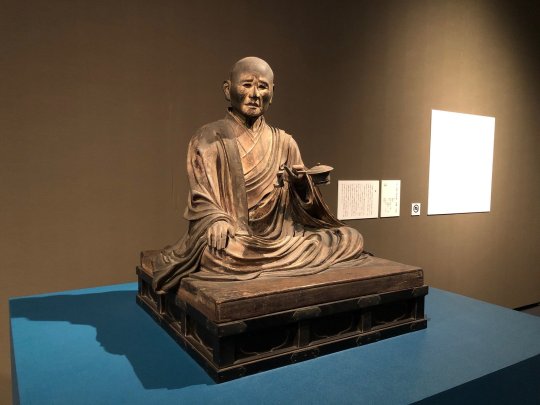
A sculpted image of the monk Jōtō (常騰) (740-815), one of the six patriarchs credited with establishing the Hossō school of Buddhism, the East Asian tradition of Yogācāra or “Consciousness Only,” in Japan
Crafted by the Buddhist artist Kōkei (康慶) in 1189 as part of the larger rebuilding of Kōfukuji Temple (興福寺) in Nara after damage sustained during the recent Genpei War and usually enshrined within the Nan’endō Hall (南円堂) of the temple but here on loan for a special exhibit at the Fukushima Prefectural Museum in Aizuwakamatsu in 2019
Photo from the official Twitter account of the Kōfukuji to Aizuten Jikkō Iinkai (興福寺と会津展実行委員会), August 12, 2019
#japanese art#buddhist art#buddhist monk#常騰#joto#法相六祖#hosso rokuso#康慶#kokei#法相宗#hosso#奈良市#nara#興福寺#kofukuji#南円堂#nanendo#福島県#fukushima prefecture#会津若松市#aizuwakamatsu#福島県立博物館#fukushima prefectural museum
16 notes
·
View notes
Text
About日本製[Nihonsei] Part 2
〜Contents〜
Traveling 47 prefectures across Japan with Haruma Miura
47 of “Made in Japan”
01 Hokkaido A close look at the history of Esashi Oiwake
02 Aomori Artist’s techniques behind the Nebuta festival
03 Iwate Visiting Tekiseisha, a workshop for Joboji Urushi lacquer
04 Miyagi Kanedai, the pride of local industry
05 Akita Encounter a power of sake at the Aramasa Sake Brewery
06 Yamagata Visiting a Yonezawa beef cattle farm
07 Fukushima The world’s best rice – visiting the Tenei rice farm
08 Ibaraki Fireworks artistry of Yamazaki Enka Manufacturing
09 Tochigi The story historic Ashikaga School tells us
10 Gunma Daimonya, the history and tradition of Takasaki Daruma craftmanship
11 Saitama Ogano Kabuki, the tradition that passed down through generations and to the future
12 Chiba Learning at the Chiba Shoyu headquarters factory
13 Tokyo History of Tsukudani unfolded at Tsukudani Marukyu
14 Kanagawa Visiting Hakkodo, the oldest manufacturer of Kamakura-bori
15 Niigata Snow Peak headquarters and outdoor gear industry
16 Toyama Massive Kurobe Dam and electric power
17 Ishikawa What Kagaya Ryokan continues to deliver
18 Fukui The glasses I touched at the Boston Club in Sabae City
19 Yamanashi Hands-on report from Kikuchi Wasabi Farm
20 Nagano To the factory house of Fujigen Guitars
21 Gifu Japanese papermaking at Minotake Kami Studio
22 Shizuoka Think about a “community” at Dot Tree Project Shuzenji
23 Aichi Touch the origin of the Toyota Motor Corporation
24 Mie Wagu – soak-up the life of Japanese lobster fisherman
25 Shiga To Daiyo- Oumi’s hand-crafted Japanese candle
26 Kyoto Discover “Project GO ON” launched by a new generation of Kyoto traditional artists
27 Osaka Visiting Ebisu at the Imamiya Shrine
28 Hyogo The weight of the salt at the Ako Marine Science Museum, Salt Country
29 Nara Carrying on the traditions to future generation at the Yamamoto Kawara Kogyo
30 Wakayama Savoring Hamadaya’s sesame tofu at the foot of Mt. Koya
31 Tottori A challenge called Sakyu Rakkyo
32 Shimane The nature and the time that support Tataraba
33 Okayama The garment factory that shines, fueling Japan Blue in the denim industry
34 Hiroshima Interview with Mr. Fumiaki Kajiya, a storyteller of Hiroshima
35 Yamaguchi Family ties at Sakae Fuku, an exquisite pufferfish restaurant
36 Tokushima Fascinated by the BUAISOU’s indigo dye
37 Kagawa Discovering the history of udon noodles at the Sanuki Menki headquarters
38 Ehime The branding of Imabari Towel
39 Kouchi Mr. Manabu Myojin, the distinguished technique of the bonito fisherman
40 Fukuoka Hakata vidro chanpon artisan, Mr. Youji Kunii and his studio
41 Saga The alure of “Tadarou-ware pottery” encountered at Kaneko Kilin
42 Nagasaki Iki – the history of Hirayama Ryokan and the island
43 Kumamoto Tenmeido – Interview with Mr. Kazuki Kitagawa about “Rokkasho -six confectioners”
44 Oita Searching for Shiramizu Kousen’s sparkling water
45 Miyazaki Visiting the third generation of Kagura mask-making craftsman
46 Kagoshima To the JAXA Tanegashima Space Center
47 Okinawa Visiting the art of Kumiodori at the National Theatre Okinawa

2 notes
·
View notes
Photo
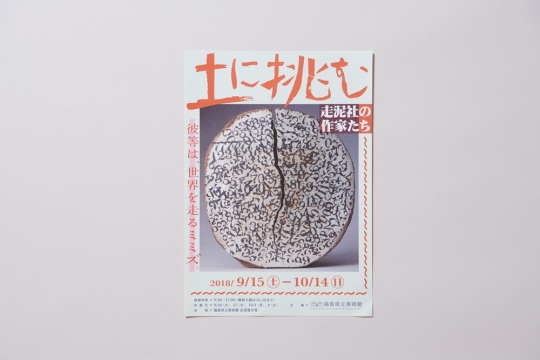
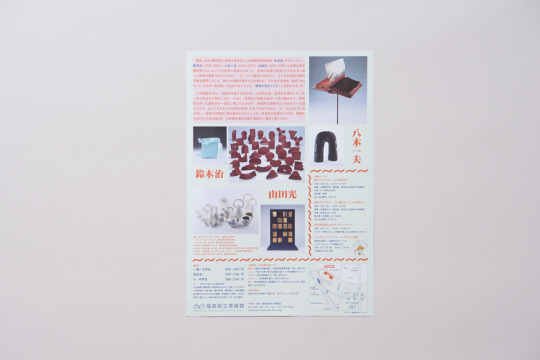


【graphic design/collage】
福島県立美術館《土に挑む -走泥社の作家たち-》
Fukushima Prefectural Museum of Art “Challenging the Soil: The Artists of Sodeisha”
1 note
·
View note
Link
The people of Sukegawa in the Fukushima prefecture, the birthplace of legendary film artist Eiji Tsuburaya, honor their hometown hero with a museum dedicated to his life and work.
15 notes
·
View notes
Photo

Day 2 part 2. Group pic in Asakusa. Yokohama. Immigration museum. Then off to Ueno to the next hotel #fukushima2019 (at Fukushima Prefecture) https://www.instagram.com/p/BtInULAgUnM/?utm_source=ig_tumblr_share&igshid=1ipj581p4pgor
1 note
·
View note